#BIOTECHNOLOGY
Text

CRISPR was already on thin fucking ice as a serious name for a biotech technique and now they made up CRISPY-BRED are you joking
4K notes
·
View notes
Text
Utik
The utik (yoo-tik) are a sophont species the rakii came in contact with when they first landed on Tkrin, their second largest moon orbiting Rek. The utik were actually the first to even set foot onto it, as they had no other choice. After suffering massive damage to their ship, the utik were forced to land on the lunar surface and hope to survive or await help.
Years later, the rakii show up, which started an a long, chaotic process of attempt of communication and debating ownership.


The bodies of the utik are actually not their true bodies. The actual sophont lies within the pearly cased cockpit. Utik like the Olac bio-mechs, mastered the technical art of bio-technology, having started on a very hot and humid planet. While unlike the Olac who switched to bio-technology as a means to evade a debilitating disease, the utik mastered it for years, working off various symbiotic organisms.
Their mech suits, or cyborg bodies you could say are symbiotic, as after their nervous and circulatory systems are linked, the pilot has full control of the suit, having it feed off waste material from the pilot. The suit then takes the waste, replenishes it, mixes it's own formula into it and feeds it back to the pilot. Like a plant, it gets a lot of energy off light and other forms of UV Retaining it for hours. These suits are suitable (ha) for open space, and lunar terran for a limited time. However proper measures are made to keep the suits tidy from "space dust" so no one goes out "naked" and risk exterior damage.
(quick sketch of utik 'pooters n screens. NOT ENTIRELY FINALIZED)
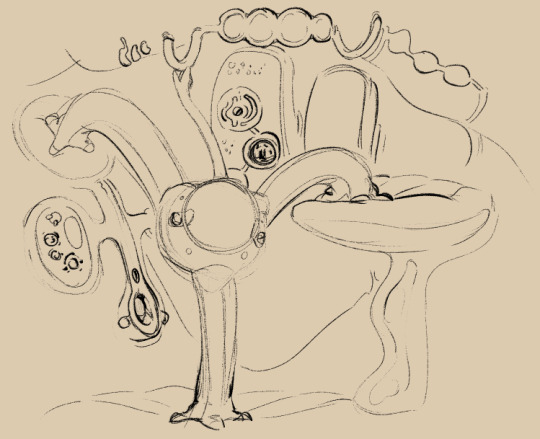
However, this isn't their true form. At least they didn't start off like this.
Way before, after they reached the ultimate feat in their development, their star was noticeably suffering, as it was predicted to eventually turn into black hole. While they had years 'till then, there wasn't enough time to perfect their original forms for the long-term space travel. So. as best they could, they learned to carefully strip and reduce themselves to nothing more than squishy muscle and brain matter, beforehand creating living space suits and sleeper pods to maintain what's left.
Several ships shot into space just in time before their star went dark and each ship jumped in different directions hoping to find and terraform a new world.
This group of utik weren't so lucky, as said before.
Now for the first half of the year, rakii and utik were on some tense terms. A lot of internal debates on who gets the moon. While utik were capable of defense, they weren't in a great position to, and the rakii weren't sure how to proceed with their first extraterrestrial contact. (Non-religious turned contact I'd guess???) UNTIL, one day it was brought ahead that, the utik secrete an anti-radiation slime. Something they came with naturally, just cranked to 10.

At first, the rakii thought to use this fluid as an applicable substance similar to sun-block, required to apply pre-spaceflight. However, it was revealed that they are extremely allergic to it. So skin-contact was a big no.
(Unfortunate rakii subject applying utik-based lotion. Results: swelling in skin, which can further cause blisters and splits)


After several trials, they came to a conclusion of using it as a gel layering in space suits, capable of absorbing radiation and protecting the wearer.
This discovery brought up a plan and a deal. It was agreed, rakii and utik would share the moon, making their first ever alliance, in exchange the utik would allow the rakii to harvest this anti-radiation goop off them, of course while exchanging knowledge, and resources.
387 notes
·
View notes
Text


tweet
#trans#this is the future#genderless#the future is genderless#science#biotechnology#ai#robotics#transhumanism#posthumanism#mine#tweets
4K notes
·
View notes
Text
Researchers have genetically engineered a marine microorganism to break down plastic in salt water. Specifically, the modified organism can break down polyethylene terephthalate (PET), a plastic used in everything from water bottles to clothing that is a significant contributor to microplastic pollution in oceans.
"This is exciting because we need to address plastic pollution in marine environments," says Nathan Crook, corresponding author of a paper on the work and an assistant professor of chemical and biomolecular engineering at North Carolina State University.
"One option is to pull the plastic out of the water and put it in a landfill, but that poses challenges of its own. It would be better if we could break these plastics down into products that can be re-used. For that to work, you need an inexpensive way to break the plastic down. Our work here is a big step in that direction."
To address this challenge, the researchers worked with two species of bacteria. The first bacterium, Vibrio natriegens, thrives in saltwater and is remarkable—in part—because it reproduces very quickly. The second bacterium, Ideonella sakaiensis, is remarkable because it produces enzymes that allow it to break down PET and eat it.
Continue Reading
419 notes
·
View notes
Text
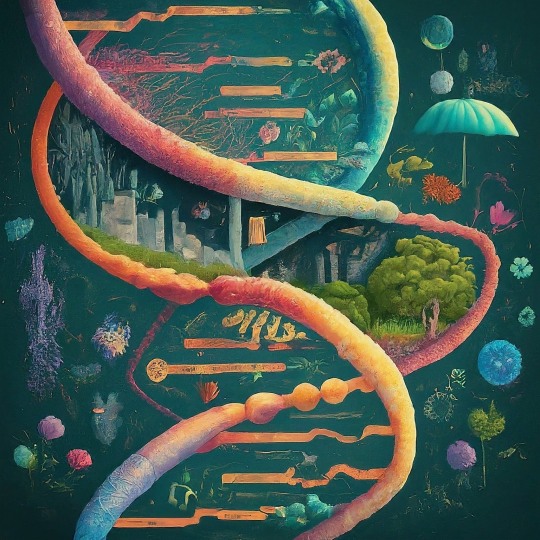
Epigenetics: A Journey Through Inheritance Beyond Genes
For centuries, scientists have been fascinated by the mysteries of heredity and how traits are passed down from generation to generation. DNA, the molecule that stores our genetic code, was once thought to be the sole determinant of our characteristics. However, a new frontier in biology, revealing a captivating layer of complexity beyond the DNA sequence itself: Epigenetics.
What is Epigenetics?
The term "epigenetics" was first coined in the 1940s by British biologist Conrad Waddington, but it wasn't until the late 20th century that its significance truly blossomed. Epigenetics, literally meaning "above genetics," refers to the study of heritable changes in gene expression that occur without alterations to the DNA sequence itself. Imagine DNA as the musical score, but epigenetics are the conductor and musicians who determine how the music is played. Through chemical modifications and adjustments to the proteins around DNA, epigenetics dictates which genes are turned on or off, influencing how cells function and ultimately shaping our health, development, and even behavior. Think of your DNA as the hardware: it contains the basic instructions for building and running your body. But epigenetics acts like the software, fine-tuning those instructions and determining which genes get turned on or off at specific times and in specific cells. These modifications, like chemical tags or changes in the packaging of DNA, don't alter the underlying code itself, but they can have a profound impact on how it's read and interpreted.
The Key Players:
DNA methylation: This process involves adding a methyl group to DNA, essentially silencing the gene it's attached to. Imagine it like putting a dimmer switch on a light bulb.
Histone modifications: Histones are proteins that package DNA, and changes in their structure can make genes more or less accessible to the cellular machinery needed for expression. Think of it like adjusting the curtains around a window - open wide for full light, slightly closed for filtered light.
Non-coding RNAs: These are molecules that don't code for proteins but can regulate gene expression in various ways. They're like the backstage crew in a play, ensuring everything runs smoothly.
The Power of Epigenetic Regulation
Epigenetic regulation plays a crucial role in various biological processes, including:
Development: During embryonic development, different cell types emerge from the same DNA blueprint by activating or silencing specific gene sets through epigenetic modifications.
Cellular differentiation: Specialized cells like muscle or nerve cells have unique functions due to differences in their active genes, controlled by epigenetic mechanisms.
Learning and memory: Epigenetic changes in brain cells are thought to be essential for learning and forming memories.
Aging: As we age, our epigenome accumulates changes that can contribute to age-related decline and disease.
Environmental influences: Diet, exercise, stress, and exposure to toxins can leave epigenetic marks on our genes, potentially impacting our health and even the health of future generations.
Epigenetics reminds us that we are not simply products of our genes. Our environment, choices, and experiences leave their mark, shaping who we are and potentially influencing our children's health. This deeper understanding of ourselves opens doors for self-awareness, empowerment, and potentially reshaping our narratives – not just as individuals, but as a species with the potential to leave a healthier legacy for generations to come.
#life science#biology#science sculpt#molecular biology#biotechnology#epigenetics#daily dose of science#dna#genetic inheritance#genetics#decoding dna#genetic code#science#double helix
103 notes
·
View notes
Text
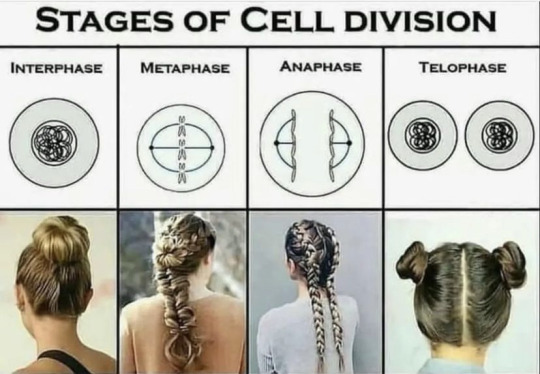
#biology#medicalschool#biotech#science#health#biologyisawesome#biologyisfun#education#celldivision#mitosis#biologystudent#cellbiology#biology facts#lifesciences#stem#biotechnology#college prep#chemistry#maths#math#motivation
1K notes
·
View notes
Text
for someone who loves computers and wishes i could be one i sure do fucking suck at math
131 notes
·
View notes
Text


“For last year's words belong to last year's language. And next year's words await another voice. And to make an end is to make a beginning."
— Little Giddings, TS Eliot
#bsc biochemistry#original#chaotic academia#stem academia#studyblr#biotechnology#heygather#heydilli#adelinestudiess#chazzastudiesalevels#problematicprocrastinator#heytess#heypeachblossom#heycoral#meestudies#mittonstudies#linksstudyblr#durhamstudies#biology#uniblr#assignment#college studyblr#productivity#100 dop#study motivation#indian studyblr#desiblr
400 notes
·
View notes
Text
Summary of the 7 Habits of Highly Effective People by Stephen Covey. This book has had a profound impact on my life, and I hope it can help you too.
The 7 Habits are:🧵
Habit 1: Be Proactive
Don't be reactive to circumstances. Take responsibility for your life and the choices you make.
Focus on the things you can control, and let go of the things you can't.
Be proactive in your relationships and interactions with others.
Habit 2: Begin with the End in Mind
Have a clear vision for your life and what you want to achieve.
Break down your vision into smaller goals and steps.
Live each day in alignment with your vision.
Habit 3: Put First Things First
Distinguish between what is urgent and what is important.
Focus your time and energy on the things that are most important.
Learn to say no to things that are not a priority.
Habit 4: Think Win-Win
Look for ways to create mutually beneficial outcomes in your relationships and interactions.
Be willing to compromise and give and take.
Focus on the interests of others, not just your own.
Habit 5: Seek First to Understand, Then to Be Understood
Listen with the intent to understand, not just to reply.
Put yourself in the other person's shoes.
Be open to learning from others.
Habit 6: Synergize
Work together with others to create something greater than what you could achieve alone.
Appreciate the unique contributions of others.
Be open to new ideas and perspectives.
Habit 7: Sharpen the Saw
Take care of yourself physically, mentally, and emotionally.
Invest in your personal growth and development.
Be a lifelong learner.
I hope you found it helpful and inspiring.
Follow @everythingaboutbiotech for more inspiring stuff.
Remember, the 7 Habits are not a magic bullet. They take time and effort to implement, but they can be incredibly powerful tools for personal and professional growth.
#self help#self esteem#note to self#self improvement#self care#self love#self worth#get motivated#motivational#motivating quotes#science#biotechnology#bioinformatics#research
226 notes
·
View notes
Text
Calling all science students and enthusiasts!!
I would absolutely love to have a science-revolving passion project and I’ve narrowed it down to a blog/blog-type-website. I love learning about science but so rarely take the time to actually research the things that interest me. With being a high school student, exams and life this is quite a big task to handle for 1 person and I’d love others to contribute to this!
This is by no means a set plan yet, I’m just sharing a rough idea, so if you could please interact with this post or dm me if you would be interested in something of this kind. Even if you see this 5 months after this was posted (and hopefully a working project or at least WIP) still reach out if you’re interested.
You don’t have to be a great writer for this either nor fascinated about each and every science. My favourite is chemistry, but it would be nice if this project could incorporate the 3 main branches of science: biology, chemistry and physics. It depends on if people would be interested in reading something like this or participating in, and their preferred subjects. You could write about astronomy as a whole, or go into chemistry and analysing electronic configuration, talking about your favourite dinosaur bones in palaeontology, a passive behaviour analysis in psychology, or explaining how exactly scabs work in biology. These would probably be short to mid-length entries and 1/2 times a month.
But this is just my idea and how far I’ve gone with it, feedback is appreciated, there will be more updates to come (not too many until afer my exams in May tho), and I appreciate any reblogs to share this idea with others!
Hopefully a couple people would like to help out in this project and please ask questions if you have any (as a dm or ask) ^^
#studyblr#uni student#university#student#a levels#science#passion project#group project#chemistry#biology#physics#medicine#astronomy#psychology#Sociology#palaeontology#botany#microbiology#toxicology#biotechnology#geology#meteorology#earth science#biochemistry#dark academia#light academia#community project#scienceblr#science blog#the sci journal
80 notes
·
View notes
Text



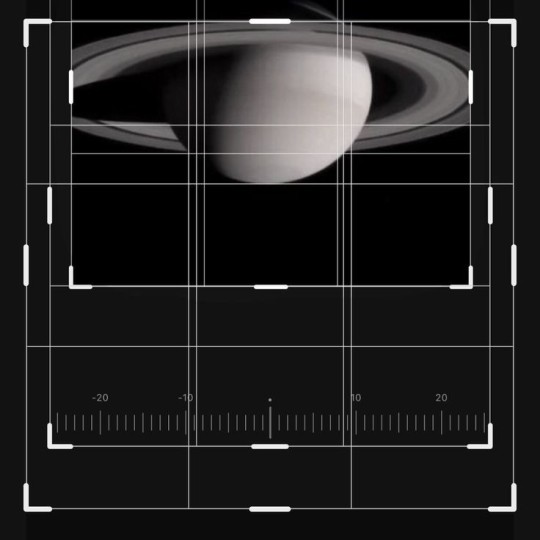



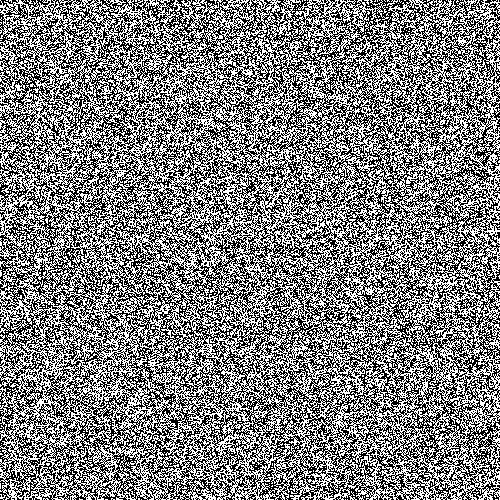
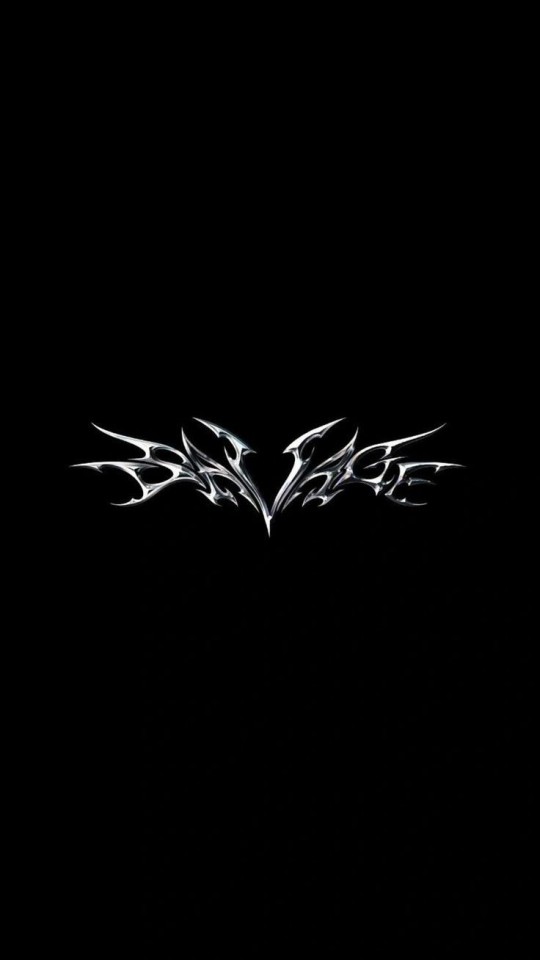
fav/reblog if u save or use.
#aespa#aespa bios#aespa users#aespa wallpapers#aespa icons#aespa kpop#winter#ningning#karina#giselle#kpop#kpop icons#icons#headers kpop#moodboard aesthetic#moodboard black#aespa moodboard#art aesthetic#biotechnology#giselle bios#karina bios#winter bios#ningning bios#kpop moodboard#kpop low quality icons#aespa lockscreens#dc universe#dark icons#dark aesthetic
1K notes
·
View notes
Text
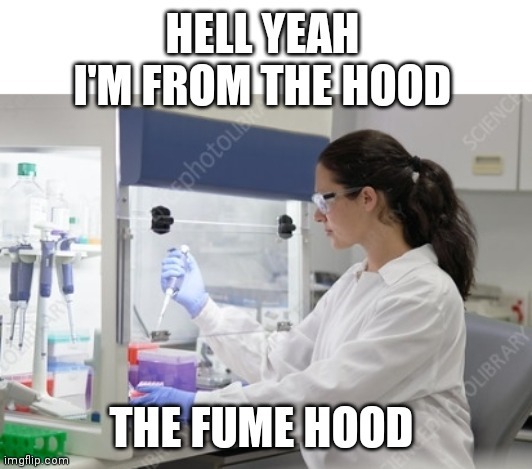
#memecular biology#science side of tumblr#science stuff#lab life#fume hood#bio lab#scientist#science memes#lab meme#lab memes#science meme#haley meming#meming from the lab#biologist#molecular biology#bio memes#biotech#biology#biotechnology#mol bio#biochem humor#bio humor#memes#nerd culture#nerdy jokes#nerdiness#nerdy#nerd memes#nerd meme#nerd humor
271 notes
·
View notes
Text
When the honeymoon phase of the semester is over and now I have two presentations, two class tests and two assignments due the next week, all of a sudden!! Like excuse me, lemme breathe for a second.
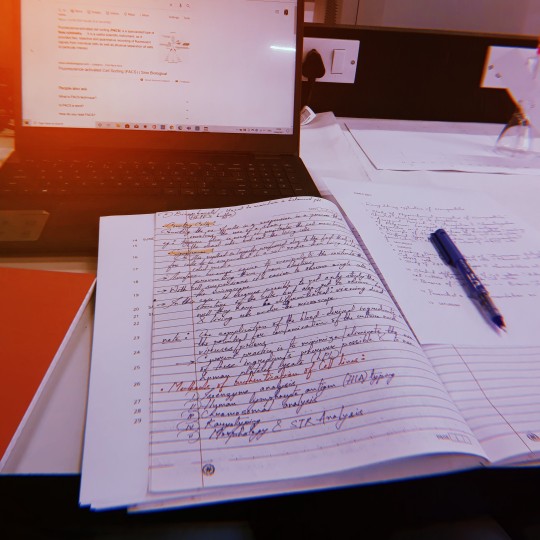
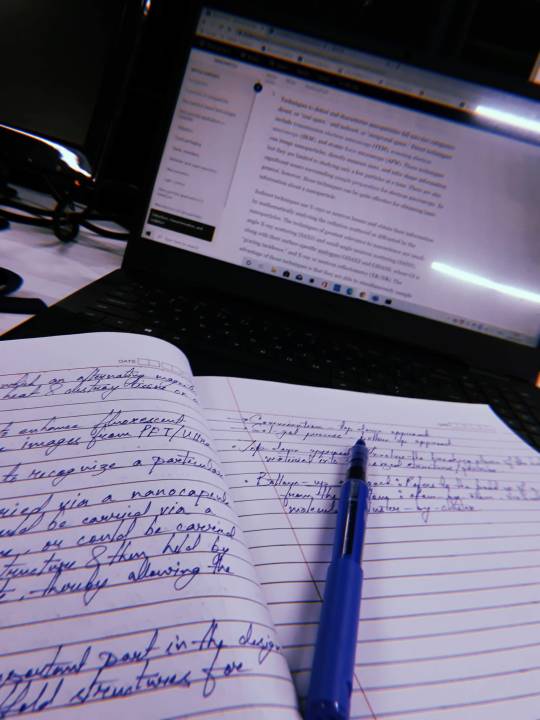
#studyblr#stem academia#academia aesthetic#academia#chaotic academia#biology academia#chaotic academia moodboard#academics#study aesthetic#studying#study desk#studyblr community#studyinspo#student life#university#molecular biology#biology#bioinformatics#biotechnology#computational biology
79 notes
·
View notes
Text
When nature performs chemical reactions to create energy-rich compounds from simple molecules, it requires energy. So far, it has not been possible to use human-made electricity to drive these biochemical processes.
Researchers at the Max Planck Institute for Terrestrial Microbiology in Marburg have achieved a breakthrough, however: they developed an artificial metabolic pathway that uses electricity to produce ATP, a biochemical energy carrier which can then be used to form energy-rich chemical compounds like starch or protein. The metabolic pathway provides a complete novel approach towards a sustainable, climate-neutral bioeconomy.
Continue Reading.
557 notes
·
View notes
Text

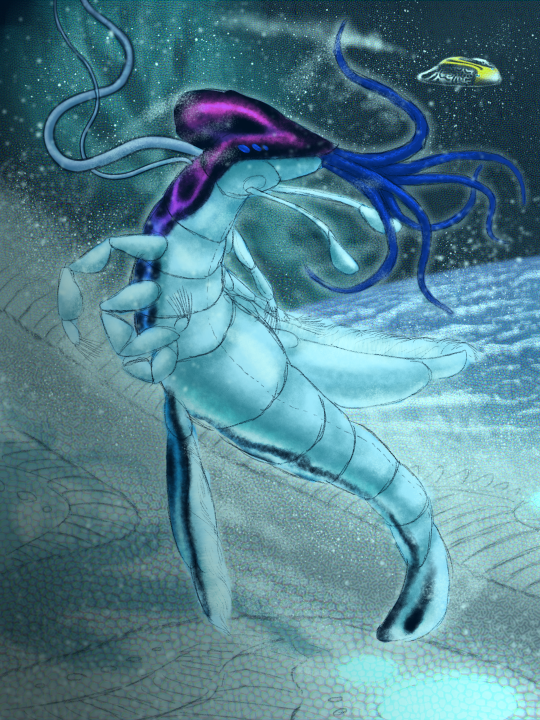

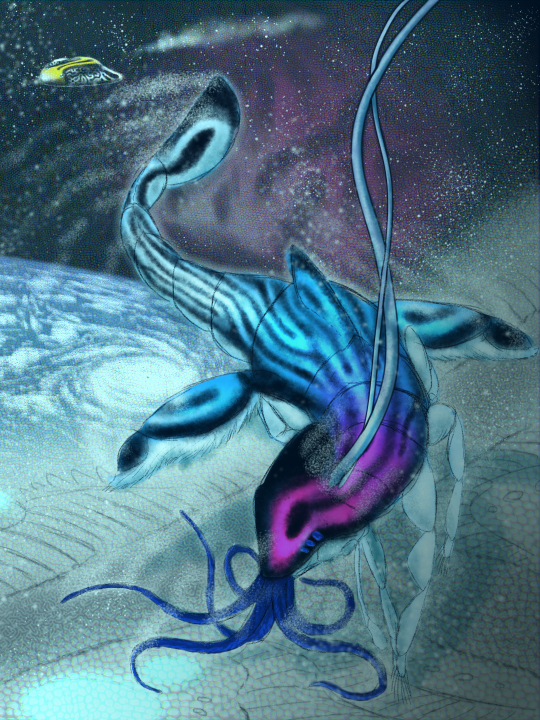
An art piece i made about 2 months ago but never got around to posting it. This was the final project for my school's art class in which we had to make a triptych
In a distant galaxy that glows a faint turquoise lies a remarkable world named Iia’Oo-uo. A tropical water world larger than Earth orbiting three suns. It is home to a menagerie of strange alien forms. The line between Plant and animal life is often very blurred. Photosynthetic life comes in shades of red, purple, yellow, and pink. Colonial organisms flourish everywhere. And radial symmetry is far more common on Iia’Oo-uo than on Earth. One such group consists of Arthropod-like organisms with eight limbs for locomotion and respiration, two antennae, six eyes, and six oral tendrils akin to the Portuguese man of war.
One such species from that phylum has made a remarkable adaptation. One that changed the course of history forever, Sapience. Referring to their people as the Uueia-Ouoo-Oo, They are a species of four-foot-long Arthropod-like predators that take on a mix of niches. But are most known for filling a role not too similar to Dolphins.
Their oral tendrils have become strong and more flexible. Aiding in catching prey and crafting tools akin to the tentacles of an octopus. They take on a vibrant shade of magenta to identify each other in the open water. And unlike most of the other alien arthropods of their world. The Uueia-Ouoo-Oo rarely use their front six limbs, only using them to hook onto the seafloor. They mostly use their rear limbs as a set of fins for swimming.
The Uueia-Ouoo-Oo are very agile swimmers. They are capable of changing between 3 different methods of aquatic locomotion. When relaxing the muscles in their entire body, they can perform Anguilliform swimming akin to eels. By stiffening muscles in the front half of their body, they can switch to a mix of Subcarangiform or Carangiform swimming akin to Trout. By tightening the muscles in their entire body, they can even switch to Median-paired fin swimming, akin to many fish native to coral reefs.
Yet despite their alien appearance, they think and act like us. They enjoy art and music and feel empathy for one another. With the lack of predators, their love and curiosity far outweighs their fear. The Uueia-Ouoo-Oo may not be human, but they capture what it means to be human.
The biggest challenge with starting a civilization underwater is the impossibility of fire and metallurgy. Where most intelligent species either stagnate or die out. The Uueia-Ouoo-Oo prevail through selective breeding and genetic engineering. Throughout their history, they have learned to modify the life around them into tools and technology.
Coral analogs are grown into vast cities. Color-changing invertebrates bred into handheld screens. And Radio communicating hives of small alien cnidarians become the backbone of the Uueia-Ouoo-Oo Internet. Life and its protection and mastery is a focal point of Uueia-Ouoo-Oo culture. Within 20 thousand years, they reshaped their entire planet in their image and created a paradise. But this is just the beginning.
Once they conquered their world, their eyes turned skyward to explore the heavens. It took over millennia to find out how to do it. Nonetheless, the Uueia-Ouoo-Oo still prevailed. They came to the idea of growing vacuum-sealed organisms capable of photosynthesis and omnidirectional jet propulsion. Chromatophores cover the interior, changing color to match what this bioship sees. Along with a tendril connected to its nervous system, allowing the pilot to insert the tendril into their head, effectively becoming one with the ship.
Lastly, they somehow learned how to create artificial wormholes, allowing the bioship to teleport anywhere in the universe. They explored the heavens with an unmatched fervor. Surveying millions of galaxies, every star within those galaxies, and every planet around those stars. All the while, they expanded at a similar pace, reshaping dead worlds into ocean worlds as beautiful as their homeworld and protecting the worlds that evolved their own alien ecosystems.
One day, during a galaxy-wide survey, they found a unique world amongst an 8-planet star system. Like millions of other worlds, this planet had life. But it had something else. One species in this world became sapient and developed a planet-wide civilization. The Uueia-Ouoo-Oo had never seen this before, and they were eager at this discovery.
Here 3 Uueia-Ouoo-Oo celebrate the discovery before their expeditionary fleet heads through the wormhole. Ready to venture to this world the natives call Earth.
#my art#artist on tumblr#speculative biology#worldbuilding#art#scifiart#sophont#biotechnology#spacescape#outer space#alien species#alien
72 notes
·
View notes
Text
A species of spider lives its entire life underwater, despite having lungs that can only breathe atmospheric oxygen. How does it do it? This spider, known as the Argyroneta aquatica, has millions of rough, water-repellent hairs that trap air around its body, creating an oxygen reservoir and acting as a barrier between the spider’s lungs and the water. This thin layer of air is called a plastron and for decades, material scientists have been trying to harness its protective effects.
39 notes
·
View notes